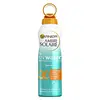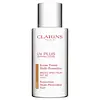What's inside
What's inside
 Key Ingredients
Key Ingredients

 Benefits
Benefits

 Concerns
Concerns

 Ingredients Side-by-side
Ingredients Side-by-side

Butane
Water
Skin ConditioningHomosalate
Skin ConditioningOctocrylene
UV AbsorberGlycerin
HumectantDimethicone
EmollientEthylhexyl Salicylate
UV AbsorberDicaprylyl Carbonate
EmollientNylon-12
Diisopropyl Sebacate
EmollientButyl Methoxydibenzoylmethane
UV AbsorberStyrene/Acrylates Copolymer
Methyl Methacrylate Crosspolymer
Cyclohexasiloxane
EmollientPolyglyceryl-6 Polyricinoleate
EmulsifyingDrometrizole Trisiloxane
UV AbsorberPentylene Glycol
Skin ConditioningP-Anisic Acid
MaskingTocopherol
AntioxidantSodium Chloride
MaskingSodium Dodecylbenzenesulfonate
CleansingSodium Benzoate
MaskingPhenoxyethanol
PreservativePEG-32
HumectantPEG-8 Laurate
EmulsifyingEthylhexyl Triazone
UV AbsorberPoly C10-30 Alkyl Acrylate
Emulsion StabilisingAloe Barbadensis Leaf Juice
Skin ConditioningCaprylyl Glycol
EmollientDisodium EDTA
Citric Acid
BufferingPotassium Sorbate
PreservativeParfum
MaskingButane, Water, Homosalate, Octocrylene, Glycerin, Dimethicone, Ethylhexyl Salicylate, Dicaprylyl Carbonate, Nylon-12, Diisopropyl Sebacate, Butyl Methoxydibenzoylmethane, Styrene/Acrylates Copolymer, Methyl Methacrylate Crosspolymer, Cyclohexasiloxane, Polyglyceryl-6 Polyricinoleate, Drometrizole Trisiloxane, Pentylene Glycol, P-Anisic Acid, Tocopherol, Sodium Chloride, Sodium Dodecylbenzenesulfonate, Sodium Benzoate, Phenoxyethanol, PEG-32, PEG-8 Laurate, Ethylhexyl Triazone, Poly C10-30 Alkyl Acrylate, Aloe Barbadensis Leaf Juice, Caprylyl Glycol, Disodium EDTA, Citric Acid, Potassium Sorbate, Parfum
Homosalate 4%
Skin ConditioningOctocrylene 4%
UV AbsorberBenzophenone-3 1.5%
UV AbsorberTitanium Dioxide
Cosmetic ColorantDimethicone
EmollientWater
Skin ConditioningAlcohol
AntimicrobialPolyglyceryl-3 Polydimethylsiloxyethyl Dimethicone
Skin ConditioningAluminum Hydroxide
EmollientStearic Acid
CleansingPEG/PPG-18/18 Dimethicone
EmulsifyingNylon-12
PEG-12 Dimethicone
Skin ConditioningSodium Chloride
MaskingPhenoxyethanol
PreservativeParfum
MaskingGlycerin
HumectantEthylhexylglycerin
Skin ConditioningTocopheryl Acetate
AntioxidantDisodium EDTA
Sanicula Europaea Extract
Skin ConditioningButylene Glycol
HumectantSodium Lauroyl Glutamate
Lysine
Skin ConditioningMagnesium Chloride
Sodium Hyaluronate
HumectantHydroxypropyltrimonium Maltodextrin Crosspolymer
Thermus Thermophillus Ferment
Skin ConditioningLapsana Communis Flower/Leaf/Stem Extract
Skin ConditioningRibes Nigrum Bud Extract
PerfumingPotassium Sorbate
PreservativeCitric Acid
BufferingCamellia Sinensis Leaf Extract
AntimicrobialCucumis Melo Fruit Extract
Skin ConditioningSodium Lauryl Sulfate
CleansingCI 77891
Cosmetic ColorantIron Oxides
Homosalate 4%, Octocrylene 4%, Benzophenone-3 1.5%, Titanium Dioxide, Dimethicone, Water, Alcohol, Polyglyceryl-3 Polydimethylsiloxyethyl Dimethicone, Aluminum Hydroxide, Stearic Acid, PEG/PPG-18/18 Dimethicone, Nylon-12, PEG-12 Dimethicone, Sodium Chloride, Phenoxyethanol, Parfum, Glycerin, Ethylhexylglycerin, Tocopheryl Acetate, Disodium EDTA, Sanicula Europaea Extract, Butylene Glycol, Sodium Lauroyl Glutamate, Lysine, Magnesium Chloride, Sodium Hyaluronate, Hydroxypropyltrimonium Maltodextrin Crosspolymer, Thermus Thermophillus Ferment, Lapsana Communis Flower/Leaf/Stem Extract, Ribes Nigrum Bud Extract, Potassium Sorbate, Citric Acid, Camellia Sinensis Leaf Extract, Cucumis Melo Fruit Extract, Sodium Lauryl Sulfate, CI 77891, Iron Oxides
Ingredients Explained
These ingredients are found in both products.
Ingredients higher up in an ingredient list are typically present in a larger amount.
Citric Acid is an alpha hydroxy acid (AHA) naturally found in citrus fruits like oranges, lemons, and limes.
Like other AHAs, citric acid can exfoliate skin by breaking down the bonds that hold dead skin cells together. This helps reveal smoother and brighter skin underneath.
However, this exfoliating effect only happens at high concentrations (20%) which can be hard to find in cosmetic products.
Due to this, citric acid is usually included in small amounts as a pH adjuster. This helps keep products slightly more acidic and compatible with skin's natural pH.
In skincare formulas, citric acid can:
While it can provide some skin benefits, research shows lactic acid and glycolic acid are generally more effective and less irritating exfoliants.
Most citric acid used in skincare today is made by fermenting sugars (usually from molasses). This synthetic version is identical to the natural citrus form but easier to stabilize and use in formulations.
Read more about some other popular AHA's here:
Learn more about Citric AcidDimethicone is a type of synthetic silicone created from natural materials such as quartz.
What it does:
Dimethicone comes in different viscosities:
Depending on the viscosity, dimethicone has different properties.
Ingredients lists don't always show which type is used, so we recommend reaching out to the brand if you have questions about the viscosity.
This ingredient is unlikely to cause irritation because it does not get absorbed into skin. However, people with silicone allergies should be careful about using this ingredient.
Note: Dimethicone may contribute to pilling. This is because it is not oil or water soluble, so pilling may occur when layered with products. When mixed with heavy oils in a formula, the outcome is also quite greasy.
Learn more about DimethiconeDisodium EDTA plays a role in making products more stable by aiding other preservatives.
It is a chelating agent, meaning it neutralizes metal ions that may be found in a product.
Disodium EDTA is a salt of edetic acid and is found to be safe in cosmetic ingredients.
Learn more about Disodium EDTAGlycerin is already naturally found in your skin. It helps moisturize and protect your skin.
A study from 2016 found glycerin to be more effective as a humectant than AHAs and hyaluronic acid.
As a humectant, it helps the skin stay hydrated by pulling moisture to your skin. The low molecular weight of glycerin allows it to pull moisture into the deeper layers of your skin.
Hydrated skin improves your skin barrier; Your skin barrier helps protect against irritants and bacteria.
Glycerin has also been found to have antimicrobial and antiviral properties. Due to these properties, glycerin is often used in wound and burn treatments.
In cosmetics, glycerin is usually derived from plants such as soybean or palm. However, it can also be sourced from animals, such as tallow or animal fat.
This ingredient is organic, colorless, odorless, and non-toxic.
Glycerin is the name for this ingredient in American English. British English uses Glycerol/Glycerine.
Learn more about GlycerinHomosalate is a chemical sunscreen filter that provides protection in the UV-B range (280nm - 320 nm), with a peak protection at 306 nm. It is internationally approved for use in sunscreens.
Homosalate is not photo-stable, meaning it's strength as a UV filter degrades over time with exposure to the sun. Because of this, it's often used in combination with other chemical sunscreen filters as avobenzone (which protects from the UV-A range). Homosalate also helps act as a solvent for harder-to-dissolve UV filters.
(Part of the reason that sunscreens need to be frequently re-applied is due to the photo instability of many chemical sunscreen filters)
Currently, homosalate is approved in concentrations up to 10% in the EU and 15% in the US. The FDA is currently doing further research on the effects of homosalate, and it is possible that these approved concentrations will change in the future.
Learn more about HomosalateNylon-12 is a polymer. It is derived from 12-aminododecanoic acid, an omega-amino fatty acid
According to a manufacturer, it is a talc substitute. Like talc, nylon-12 gives products a satin feel. The manufacturer also claims this ingredients does not block pores and has moderate oil absorption.
This ingredient may not be reef-safe.
Learn more about Nylon-12Octocrylene protects skin from sun damage. It absorbs UV-B with peak absorption of 304 nm. It is a common sunscreen ingredient and often paired with avobenzone, a UVA filter. This is because octocrylene stabilizes other sunscreen ingredients by protecting them from degradation when exposed to sunlight. Octocrylene is a photostable ingredient and loses about 10% of SPF in 95 minutes.
Octocrylene also acts as an emollient, meaning it helps skin retain moisture and softens skin. It is oil-soluble and hydrophobic, enhancing water-resistant properties in a product.
Those who are using ketoprofen, a topical anti-inflammatory drug, may experience an allergic reaction when using octocrylene. It is best to speak with a healthcare professional about using sunscreens with octocrylene.
The EU allows a maximum of these concentrations:
Learn more about OctocryleneParfum is a catch-all term for an ingredient or more that is used to give a scent to products.
Also called "fragrance", this ingredient can be a blend of hundreds of chemicals or plant oils. This means every product with "fragrance" or "parfum" in the ingredients list is a different mixture.
For instance, Habanolide is a proprietary trade name for a specific aroma chemical. When used as a fragrance ingredient in cosmetics, most aroma chemicals fall under the broad labeling category of “FRAGRANCE” or “PARFUM” according to EU and US regulations.
The term 'parfum' or 'fragrance' is not regulated in many countries. In many cases, it is up to the brand to define this term.
For instance, many brands choose to label themselves as "fragrance-free" because they are not using synthetic fragrances. However, their products may still contain ingredients such as essential oils that are considered a fragrance by INCI standards.
One example is Calendula flower extract. Calendula is an essential oil that still imparts a scent or 'fragrance'.
Depending on the blend, the ingredients in the mixture can cause allergies and sensitivities on the skin. Some ingredients that are known EU allergens include linalool and citronellol.
Parfum can also be used to mask or cover an unpleasant scent.
The bottom line is: not all fragrances/parfum/ingredients are created equally. If you are worried about fragrances, we recommend taking a closer look at an ingredient. And of course, we always recommend speaking with a professional.
Learn more about ParfumPhenoxyethanol is a preservative that has germicide, antimicrobial, and aromatic properties. Studies show that phenoxyethanol can prevent microbial growth. By itself, it has a scent that is similar to that of a rose.
It's often used in formulations along with Caprylyl Glycol to preserve the shelf life of products.
Potassium Sorbate is a preservative used to prevent yeast and mold in products. It is commonly found in both cosmetic and food products.
This ingredient comes from potassium salt derived from sorbic acid. Sorbic acid is a natural antibiotic and effective against fungus.
Both potassium sorbate and sorbic acid can be found in baked goods, cheeses, dried meats, dried fruit, ice cream, pickles, wine, yogurt, and more.
You'll often find this ingredient used with other preservatives.
Learn more about Potassium SorbateChances are, you eat sodium chloride every day. Sodium Chloride is also known as table salt.
This ingredient has many purposes in skincare: thickener, emulsifier, and exfoliator.
You'll most likely find this ingredient in cleansers where it is used to create a gel-like texture. As an emulsifier, it also prevents ingredients from separating.
There is much debate on whether this ingredient is comedogenic. The short answer - comedogenic ratings don't tell the whole story. Learn more about comegodenic ratings here.
The concensus about this ingredient causing acne seems to be divided. Research is needed to understand if this ingredient does cause acne.
Scrubs may use salt as the primary exfoliating ingredient.
Learn more about Sodium ChlorideWater. It's the most common cosmetic ingredient of all. You'll usually see it at the top of ingredient lists, meaning that it makes up the largest part of the product.
So why is it so popular? Water most often acts as a solvent - this means that it helps dissolve other ingredients into the formulation.
You'll also recognize water as that liquid we all need to stay alive. If you see this, drink a glass of water. Stay hydrated!
Learn more about Water